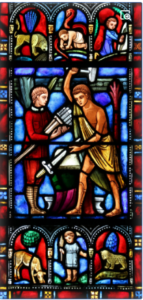They shall beat their swords into plowshares.
Mount Calvary Church
A Roman Catholic Parish
The Personal Ordinariate of S. Peter
Eutaw Street and Madison Avenue
Baltimore, Maryland
December 1, 2019
Advent I
Rev. Albert Scharbach, Pastor
Dr. Allen Buskirk, Choirmaster
Midori Ataka, Organist
8:00 A.M. Said Mass
10:00 A.M. Sung Mass
Brunch to follow in the undercroft
_______________
Common
Anglican Folk Mass, Shaw
_______________
Anthems
Rorate coeli, William Byrd (1540-1623)
Rorate caeli desuper, et nubes pluant justum: aperiatur terra, et germinet salvatorem. Benedixisti, Domine, terram tuam: avertisti captivitatem Jacob. Gloria Patri, et Filio, et Spiritui Sancto. Sicut erat in principio, et nunc, et semper, et in saecula saeculorum, amen.
Drop down ye heavens, from above, and let the skies pour down righteousness: Let the earth open and bring forth a Saviour. Lord, thou hast blessed thy land: Thou hast turned away the captivity of Jacob. Glory be to the Father, and to the Son, and to the Holy Ghost. As it was in the beginning, is now, and ever shall be, world without end, amen.
_________
Laetentur coeli, William Byrd (1540-1623)
Laetentur coeli, et exultet terra. Jubilate montes laudem, quia Dominus noster veniet, et pauperum suorum miserebitur. Orietur in diebus tuis justitia et abundantia pacis.
Let the heavens be glad and let the earth rejoice. Let the mountains be joyful with praise, because our Lord will come, and will show mercy to his poor. In your days, justice and abundance of peace shall arise.
Laetentur coeli, the communion anthem, is an early work by Byrd, published in 1589 in a compilation of sacred Latin motets by Byrd and Tallis. The text is from a processional respond for Sundays in Advent from the Sarum rite. The music is set for five voices on a text from Isaiah 49:13 with a contrasting three-part texture for second half from Psalm 71:7. Listen for the shouts of exultation as the earth rejoices “et exultet terra” and for the gentle kindness of the Lord’s mercy on the poor “et pauperum suorum miserebitur;” this text is then repeated after the psalm verse to close the piece.
____________________
Hymns
#3 Wake, awake, for night is flying(WACHET AUF) is by Philipp Nicolai (1556-1608), translated by Catherine Winkworth (1827-1878). It is partly based on Matthew 25: 1-13, the parable of the wise and foolish virgins. Nicolai was a pastor in Westphalia during a terrible pestilence, which claimed some thirteen hundred lives in his parish alone. Nicolai turned from the constant tragedies and frequent funerals (at times he buried thirty people in one day) to meditate on “the noble, sublime doctrine of eternal life obtained through the blood of Christ.” We look forward to the glorious coming of Jesus when He will deliver us from death and bring us into the kingdom of His Father. Christ’s light shining in the darkness of death to deliver us is a profound theme of Advent.
People, look east (BESANCON CAROL) is by Eleanor Farjeon (1881-1965). The delight of the poem is in its idea that ‘Love the Guest’ (stanza 1) is coming, and must be made welcome: his name is kept back until the last stanza, when He is at last named as ‘the Lord.’ Before that the phrase ‘People, look East,’ found in the penultimate line of every stanza, is a reminder of the rising of the sun, and the coming of light; and just as Christmas comes in the middle of winter, so the singer is reminded of seeds lying dormant in the cold earth, seeds of the rose of summer (stanza 2), and of birds building their nests so that new birth can come (stanza 3). Stanza 4 is a reminder of the light that comes from the stars, the light that shines in the darkness (from John 1: 1-14). Throughout the poem the images of life are contrasted with winter cold and darkness, until in the final stanza the Christ who is Lord is revealed in all His wonder and glory
#7 Hark the glad sound, the Saviour comes (BRISTOL) is by Philip Doddridge (1702-1751). The text on which it is based concerns the preaching of Christ in the synagogue. The hymn follows the scriptural account closely. It shows Doddridge’s art very clearly, especially his ability to balance the first half of a stanza against the second.
